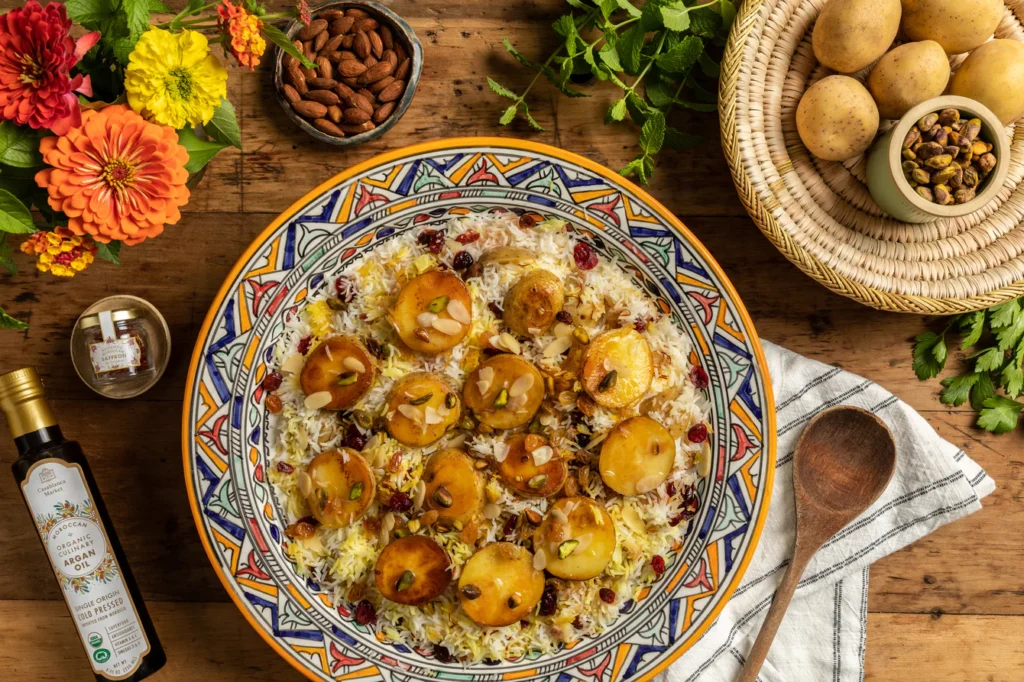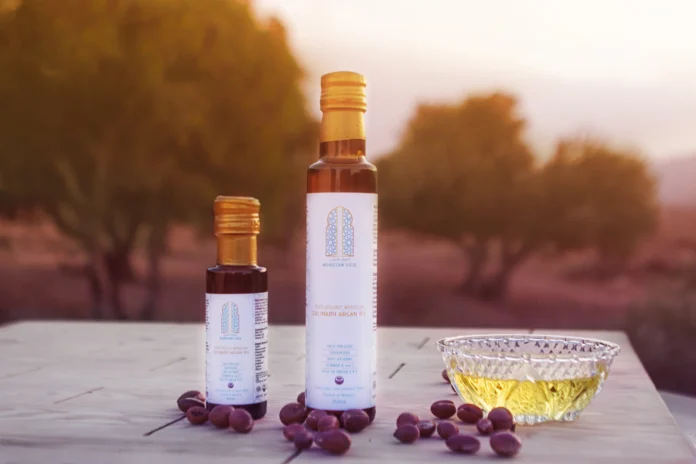Introduction
Greetings readers! My name is Amira and I want to warmly welcome you to Morocco. I hope you’re all ready for an magical culinary journey across this beautiful North African country. Together, we’ll explore the secrets behind some of Morocco’s most treasured delicacies and uncover how a single, remarkable ingredient has gained almost mythical status amongst cooks both near and far – argan oil.
As a native Moroccan, I’ve grown up surrounded by the unique flavors and aromas that define Moroccan cuisine. I still vividly remember the first time I tasted buttered toast cooked in argan oil. The rich, nutty essence just transported me and awakened my senses. From that moment on, I was hooked! I knew I had to learn more about this special oil and discover how it could enhance other dishes.
Over the years, I’ve had great fun experimenting in the kitchen and developing recipes that highlight argan oil’s wonderful properties. I’m now eager to share some of my favorites with all of you. Are you ready to join me on a culinary adventure full of magical discoveries? Then let’s get started!
The Treasured Gift of Argan Oil
Nestled between the blue waters of the Atlantic Ocean and the towering peaks of the Atlas Mountains lies Morocco – a land cloaked in mystery, beauty and cultural intrigue. At its heart is Moroccan cuisine, packed with layers of complex flavors and spices shaped by over 1,000 years of invasions and cultural influences.
One of Morocco’s most prized culinary secrets is argan oil. Extracted from the nuts of endemic argan trees found only in a small region of Southwestern Morocco, argan oil holds almost mythical status for its diverse uses and health benefits. The Berber people first discovered its unique properties centuries ago and it’s been an integral part of Moroccan cooking traditions ever since.
But what makes argan oil so special? Well, it’s packed with nourishing vitamins, minerals and fatty acids that are superb for both internal and external wellness. Some of its key compounds include:
- Vitamin E (tocopherol): A powerful antioxidant that helps protect cells from damage.
- Phenolic compounds: Plant-based molecules with anti-inflammatory and antimicrobial properties.
- Oleic acid: The main fatty acid in olive oil, shown to support heart health.
- Linoleic acid: An essential fatty acid that supports skin health and supple joints.
- Squalene: A triterpene that moisturizes skin and may help slow aging.
When taken internally, argan oil aids digestion, nourishes the nervous system and supports a healthy heart. Externally, it deeply moisturizes skin and hair while helping reduce signs of aging. Little wonder then that it holds such an allure!
However, argan oil’s rarity once made it a closely guarded secret. Only the indigenous Berber women knew how to extract the oil through a laborious traditional process. It was reserved for special occasions or gifts to honor esteemed guests. Thankfully, sustainable production has increased argan oil’s availability in recent decades. While it remains a luxury outside of Morocco, more people worldwide can now enjoy its culinary and beauty treasures.
In this post, I hope to shed light on argan oil’s rich cultural heritage in Morocco and introduce you to some of its magical uses in my treasured recipes. Are you ready to dive into a world of exotic flavors? Let’s get cooking!
Sweet & Savory Breakfast Goods
In Morocco, the most important meal of the day is breakfast. We take our time enjoying a lavish spread of sweet and savory delights to fuel us for the day ahead. Argan oil enhances many classic Moroccan breakfast items with its nutty richness. Here are a few of my favorites:
Fluffy Argan Oil Pancakes
These light and fluffy pancakes are so tasty topped with honey, fig preserves or bananas. The secret is using just a spoonful of argan oil which leaves the pancakes moist and full of flavor.
Ingredients
- 1 cup all-purpose flour
- 2 tbsp argan oil
- 1 1/2 tsp baking powder
- 1/4 tsp salt
- 1 cup milk
- 1 egg
- Butter for cooking
Instructions
- Mix the dry ingredients (flour, baking powder, salt) in a large bowl.
- In a separate bowl, whisk together the wet ingredients (milk, egg, argan oil).
- Make a well in the center of the dry ingredients and pour in the wet ingredients. Whisk until just combined but still slightly lumpy.
- Heat a skillet over medium heat and add a knob of butter. Scoop pancake batter and cook until bubbles form, about 2 minutes. Flip and cook the other side until golden brown.
- Serve warm with your choice of toppings like honey, jam or fruit. Enjoy!
Buttery Toast with Argan Oil
The perfect quick breakfast – bread toasted in argan oil until crisp and golden. Drizzle with more oil and a sprinkle of za’atar for extra flavor.
Ingredients
- Bread slices
- Argan oil
- Za’atar (optional)
Instructions
- Heat a skillet over medium heat.
- Brush one side of bread generously with argan oil.
- Place oiled side down into hot skillet. Cook until browned and crisp, about 2-3 minutes.
- Flip bread, brush other side with oil and cook another 2 minutes.
- Serve hot, drizzled with more argan oil and sprinkled with za’atar if desired.
Spiced Argan Oil Granola
Full of texture and nutty taste, this energizing granola makes a great grab-and-go breakfast. The argan oil keeps it moist.
Ingredients
- 3 cups rolled oats
- 1/2 cup pumpkin seeds
- 1/2 cup sunflower seeds
- 1/3 cup sliced almonds
- 1/4 cup argan oil
- 1/4 cup honey or maple syrup
- 1 tbsp cinnamon
- 1/2 tsp salt
Instructions
- Preheat oven to 300°F. Line a large baking sheet with parchment paper.
- In a large bowl, mix together the oats, seeds, almonds, cinnamon and salt.
- In a small saucepan, heat the argan oil and honey until runny.
- Pour the oil-honey mixture over the oat mixture and stir until fully coated.
- Spread granola onto prepared pan in an even layer.
- Bake for 30-40 minutes, stirring every 10 minutes, until golden brown.
- Allow to cool completely before storing in an airtight container. Enjoy!
Those are just a few of my favorite Moroccan breakfast recipes featuring argan oil’s rich goodness. I hope they give you a tantalizing taste of our breakfast culture. The best part is knowing argan oil delivers nutrients to energize you for the day ahead. Up next, we’ll explore some classic Moroccan tagines perfect for sharing family-style meals.

Signature Tagines: A Taste of Morocco
Tagines are the undisputed stars of Moroccan cuisine – conical clay pots that beautifully braise ingredients using a unique cooking method. Traditionally slowly cooked over charcoal, tagines infuse foods with intense layers of flavor. No Moroccan meal is complete without at least one gently simmered tagine. Argan oil takes these dishes to new heights, so I’ve selected a few of my top recipes for you to savor.
Chicken Tagine with Prunes, Almonds & Saffron
Rich in flavor yet light on the stomach, this tagine is perfect for celebrating special occasions. Argan oil contributes nuttiness while saffron adds a subtle warmth.
Ingredients
- 1.5 lbs chicken thighs or drumsticks
- 1 tbsp argan oil
- 1 onion, diced
- 3 cloves garlic, minced
- 1 cinnamon stick
- 1 tsp ground ginger
- 1/4 tsp saffron threads
- 1 cup prunes
- 1/2 cup chopped almonds
- Salt and pepper to taste
- 2 tbsp argan oil
- Chopped cilantro to garnish
Instructions
- Season chicken with salt and pepper. Heat 1 tbsp oil in large skillet over medium-high heat. Working in batches, brown chicken pieces on all sides, about 5-7 minutes total. Transfer to plate.
- Add remaining 1 tbsp oil to skillet if needed. Sauté onion, garlic, cinnamon and spices until softened, 5-7 minutes.
- Place contents of skillet into tagine. Add chicken and any accumulated juices. Pour in 1/2 cup water.
- Cover and simmer for 1-1.5 hours until chicken is tender. Add prunes and almonds during last 30 minutes.
- Stir in remaining 2 tbsp argan oil before serving. Garnish with cilantro. Enjoy!

